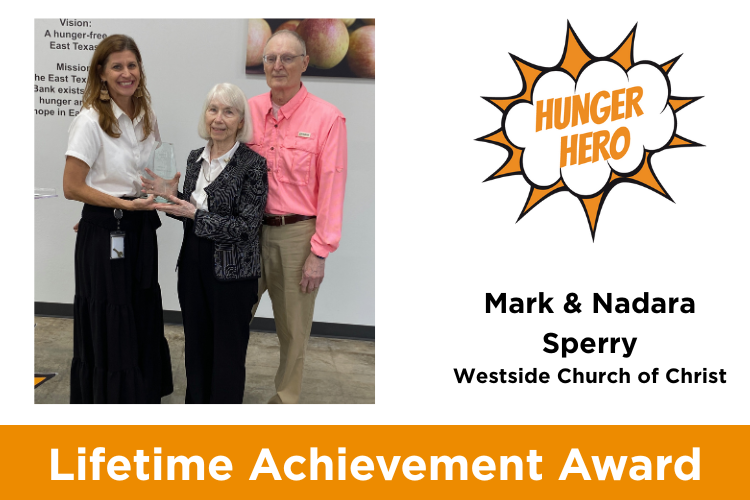The East Texas Food Bank (ETFB) honored recipients with the sixth annual Hunger Hero Awards as part of Hunger Action Month.
Corporate Partner
Texas Materials receive the Corporate Partner Hunger Hero award.
“We are so grateful to Texas Materials for their support of our mission in Lufkin,” said Tim Butler, Chief Development Officer of the East Texas Food Bank. “They have volunteered with us for several years at the Deep East Texas Resource Center. Then last year, we asked for a bid for a new dumpster and concrete pad, and they donated the project to us totaling $21,000, which helped save the food bank money so we could use our resources to provide more meals to our neighbors in Angelina County.”
“At Texas Materials we believe the work the ETFB is doing within East Texas is crucial in providing our partners within the community the resources they need when it is needed most,” said Bobby Daggett, General Manager with Texas Materials. “The assistance the ETFB provides aligns closely with our core value of People Being Our Priority and caring for each other’s safety and well-being. Texas Materials is proud of our partnership with ETFB and look forward to continuing working together to serve our partners in the community.”
Community Partner
First Baptist Church Lufkin received the Community Partner Hunger Hero award.
“FBC Lufkin has been partners of ETFB since 2022, they are one of our biggest and steadfast partners who believe in what we do,” said Butler.
“First Baptist Church Lufkin is grateful to have the opportunity to support the East Texas Food Bank,” said Walker McWilliams, Associate Pastor of First Baptist Church Lufkin. “We know that food insecurity is a prominent issue in our community, and as followers of Christ, we are called to feed the hungry as Jesus did. We are thankful to partner with a compassionate and professional organization that provides consistent food to those who need it.”
Community Partner-Linden Methodist Church
Pastor Kara Mitchell with Linden Methodist Church received a Community Partner Hunger Hero Award.
“The dedicated volunteers with Linden Methodist Church have contributed hundreds of hours in support of the ETFB Mobile Pantry Program,” said Kim Morris, Chief Impact Officer, with the East Texas Food Bank. “Pastor Kara Mitchell cultivated a passionate team of service-minded individuals from her congregation who, rain or shine, distributed fresh produce to neighbors in Cass County. Their record high for a single distribution reached an incredible 547 households, with their monthly average ranging between 328 and 415 households served. Today, the church has transitioned into managing the senior box program and once again Pastor Kara has led with vision and heart, guiding the team through this change and into a new phase of service.”
“Our church supports the ETFB because there is a need, and our faith calls us to do it,” said Pastor Kara Mitchell, with Linden Methodist Church. “According to Galatians 6:10 the Bible says, ‘So then, whenever we have an opportunity, let us work for the good of all, and especially for those of the family of faith.’ Supporting a food bank is a perfect way for our church to meet the needs of our community. It fulfills God’s desire for us to provide compassion, while building connections and providing hope for those in need.”
Community Partner- Shepherd’s Harvest Food Pantry
Pastor Chad Mitchell with Hughes Springs Methodist Church and Shepherd’s Harvest Food Pantry also received a Community Partner Hunger Hero Award.
“A few years after coming on as a pantry partner, they adopted the Hughes Springs senior box distribution,” said Morris. “They have been successfully executing both programs as a model site. They have several volunteers and are a lifeline for the residents in their community. They accepted fighting hunger and feeding hope in a food desert and have provided an oasis to those in need.”
“At Shepherds Harvest Food Pantry, we recognize that we have neighbors in our community that often have to make decisions when prioritizing their needs,” said Pastor Chad Mitchell with Hughes Springs Methodist Church. “It is our hope that by providing assistance with our pantry and through the ETFB Senior Box Program, that we may be the hands and feet of Christ, ministering to the spiritual and physical needs of our neighbors.”
Lifetime Achievement Award
Mark and Nadara Sperry with Westside Church of Christ received the Hunger Hero Lifetime Achievement Award.
The Westside Church of Christ pantry opened in 1999. Today the church provides 3,500 pounds of food on average each month to the people of Texarkana.
“The Sperry’s became involved with the pantry and have helped guide and shape it into its current form,” said Morris. “They have a huge volunteer base of 50 dedicated community members from multiple churches and have made great strides to serve this unique border city. Their contributions and tireless efforts have been instrumental in their continuing success.”
“We first volunteered in the pantry 20 years ago because we firmly believed that Jesus wanted us to share what He had given us,” said Nadara Sperry. “We have continued to work because of the many stories from the grateful people who receive boxes each month. They have told us repeatedly that a monthly box of food makes a significant difference in their lives.”
Corporate Partner- Atmos Energy
Atmos Energy received a Corporate Partner Hunger Hero Award.
“Atmos Energy has been a great partner in helping with our Longview Resource Center and other programs,” said David Emerson, CEO of the East Texas Food Bank. “Through our relationship with Atmos, their donations have provided over 550,000 meals.”
“We are passionate about giving back to the communities we serve, and it has been an honor to have such a strong partnership with East Texas Food Bank over the past five years,” said Darwin Winfield, Atmos Energy public affairs manager. “ETFB shares our commitment to Fueling Safe and Thriving Communities by providing critical resources to help fight childhood hunger. We are so thankful for this recognition and look forward to continued collaboration for many more years to come.”
Corporate Partner- Hall Family of Dealerships
Also receiving a Corporate Partner Hunger Hero Award is the Hall Family of Dealerships.
“The Hall Family of Dealerships has been very supportive of what we do at the East Texas Food Bank,” said Emerson. “Through our partnership with them their donations have helped us provide over 400,000 meals.”
“We certainly believe in their exceptional programs,” said Pam Hall, owner of Hall Family of Dealerships. “I was so impressed by the ‘shopping’ market, so families felt comfortable and on top of that the service they provided for health purposes. I completely believe in the integrity of the people there and their mission.”
Community Partner- ETX ADAM
East TX ADAM (Acquisition, Divestitures and Mergers) received a Community Partner Hunger Hero Award.
“East TX ADAM approached ETFB a few years ago to see if we could partner with them on their annual golf tournament with the proceeds going to the food bank,” said Emerson. “This has been a wonderful relationship, and we are so pleased that this tournament has raised funds to provide over 270,000 meals.”
“Three years ago, I made the recommendation to the other board members that it was time for us to put the profits from the tournament to good use,” said Todd Upson, board member of East TX ADAM. “We discussed the situation and felt with our group having members throughout East Texas, and with the number of kids and families having such a difficult time of putting enough food on the table, it only made sense for the profits to go to the East Texas Food Bank. I thoroughly enjoy our relationship with the food bank, and we all know the financial assistance is being put to good use. This coming October will be the fourth year the food bank has been the benefactor from the East Texas ADAM Charity Golf Tournament.”
Community Partner- St. Vincent de Paul
Also receiving a Community Partner Hunger Hero Award is St. Vincent de Paul of Tyler while former pantry manager Michael Allgaier, who died in March, is receiving posthumously a Lifetime Achievement Award.
“St. Vincent de Paul is one of our larger pantry partners who deeply cares about taking care of people’s needs in our community,” said Emerson. “Just since 2012, the pantry has served more than 1.7 million meals.”
“We support the ETFB because they support us in meeting the hungry where they are at,” said Grace Vierling, Executive Director with St. Vincent de Paul. “We are partners in the fight for food security and are proud to join them in this mission of hope.”
Lifetime Achievement Award- Michael Allgaier, St. Vincent de Paul
“Mike Allgaier was a tireless servant leader for the Society of St. Vincent de Paul,” added Vierling. “He spent years serving and caring for those in the most need in our community. His dedication and ingenuity helped expand our ministry to what it is today. We miss him dearly and are proud to continue his legacy.”
“Mike was a kind, generous man with a heart fully dedicated to serving others,” said Anita Bangle, ETFB Retail Store Donation Coordinator. “St. Vincent de Paul joined our partner agency retail store donation program and he was deeply committed to representing ETFB with excellence.”
ETFB presented the awards during Feeding America’s Hunger Action Month, held each year in September, to inspire the community to take action and bring attention to hunger in East Texas and the nation.
According to Feeding America’s Map the Meal Gap study, 1 in 5 East Texans including 1 in 4 children are hungry. This amounts to 235,670 adults including 80,370 children in East Texas are food insecure.










